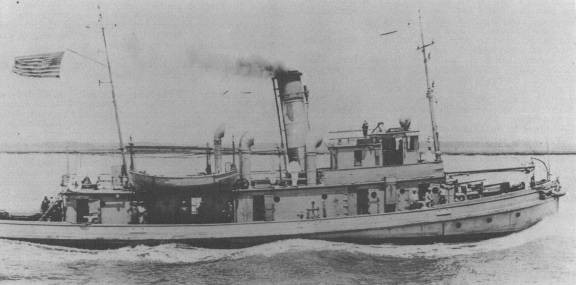Wando II (Tug No. 17)

(Tug No. 17: displacement 575 tons; length 123'6½"; beam 26'8"; draft 11'6" (mean); complement 23; armament 2 3-pounders; cl. Wando)
The second Wando (Tug No. 17) was named for a tribe of Indians of the Muskhpgean language Indian group who lived in South Carolina on the banks of the Cooper River
II
The second Wando (Tug No. 17) was laid down on 14 June 1915 by the Charleston (S.C.) Navy Yard; launched on 7 March 1916; and commissioned on 3 April 1917, Boatswain J. W. Bettens in command.
Wando remained at Charleston until 15 April, when she got underway for New England waters and, with the ferryboat Wave in tow, steamed north, via Lynnhaven Roads, Va., and the New York Navy Yard, arriving at Newport six days later. Shifting to Boston, Mass., via the Cape Cod Canal, soon thereafter, the tug towed a coal barge to the New York Navy Yard on 25 and 26 April and subsequently towed the cruiser Salem from Philadelphia to the Boston Navy Yard before she returned, via Philadelphia, to Charleston on 19 May, towing the torpedo boat Barney.
After brief tours of duty at Georgetown, S.C., and Jacksonville, Fla., Wando sailed for Hampton Roads, Va., anchoring with the Fleet in the York River on 11 June. Through the summer, the tug performed various utility duties (mostly towing targets and lighters; shifting target rafts and planting buoys) out of Tangier Sound and Yorktown, Va. During that time, she assisted the grounded battleship Louisiana (Battleship No. 19) on 6 July.
In mid-August, Wando underwent repairs at the Norfolk Navy Yard and there received a "minesweep-ing outfit." She departed Norfolk on 23 August, heading for New York waters, and reached "Base 10," Port Jefferson, Long Island, on the morning of the 25th. From there, the tug shifted to New London, Conn., where she received additional minesweeping gear from Baltimore. On the evening of 8 September, Wando embarked Capt. Reginald R. Belknap, Commander, Mine Force, and transported him to Newport, R.I., arriving there later that evening. The tug subsequently performed buoy and net-tending functions off the Cornfield Light Vessel from 10 to 13 September.
Wando returned to New London on the 16th and the following day had more minesweeping gear installed. She again transported Capt. Belknap as a passenger, from New London to Newport, before heading for Norfolk. For the remainder of September, Wando operated at "Base One," Tangier Sound, mooring target rafts, working on target moorings, and conducting brief trips for repairs or supplies at the Norfolk Navy Yard. Wando subsequently remained in the Chesapeake Bay-Hampton Roads-Tangier Sound region through the autumn months and into the winter.
Detached from her duty with the Mine Force on 19 November 1917, Wando resumed her operations with the Atlantic Fleet Train. However, she continued to perform the same basic duties, serving as target/net tender and delivering mail and dispatches through the end of March 1918. She subsequently towed targets for battleships engaging in gunnery exercises off the southern drill grounds, off the Virginia capes, and later laid buoys at the Potomac River Torpedo Range, off the mouth of the St. Mary's River.
Wando was deployed in the Caribbean for the first time in early 1919. Underway from Norfolk on 6 February 1919, the tug arrived at Guantanamo Bay on 14 February, with Pontoon No. 23 in tow. She performed her unglamorous service functions for the Fleet-towing targets, lighters, barges, and delivering men and mail-in Cuban waters (Guantanamo Bay, Guacanayabo Bay, and Manzanillo Bay) until 17 April, when she headed home.
Reaching New York on the 18th, Wando subsequently shifted to Hoboken, N.J., where she underwent repairs over the first few days of May. Returning to Norfolk on 6 May, Wando towed targets and performed general utility service with the Atlantic Fleet Train through mid-July and then operated in waters off the northern part of the eastern seaboard, out of Newport, New London, and New York. She remained at New York City from 10 August 1919 to 10 January 1920.
Underway for Norfolk on the latter day, Wando arrived there the next day but, on the 14th, sailed south for Charleston and reached that port on the 16th. Detached from the Atlantic Fleet Train on 26 January 1920, Wando was simultaneously assigned duties as a yard craft at the Charleston Navy Yard, her crew reduced to 14 men. While on active duty at Charleston, she was classified AT-17 on 17 July 1920, during the fleet-wide assignment of alphanumeric hull numbers.
Wando operated in the 6th Naval District, out of Charleston, until 18 April 1922, when she was decommissioned and placed in reserve.
Recommissioned at the Mare Island Navy Yard, Vallejo, Calif., on 15 March 1933, Wando was reclassified on 27 February 1936 from a seagoing tug (AT) to a harbor tug, YT-123. On 15 April 1944, she was reclassified again to a large harbor tug, YTB-123, a classification she carried for the remainder of her active naval service.
Assigned to the 13th Naval District after her recommissioning to operate at the Puget Sound Navy Yard, Bremerton, Wash., Wando performed her vital but unsung tug services from the late 1930's through World War II. Ultimately placed out of commission and out of service on 3 July 1946, Wando was delivered to the Maritime Commission's War Shipping Administration for disposal. Her name was struck from the Navy list on 30 December 1946, and she was acquired by the Puget Sound Tug and Barge Co. on 28 April 1947.
29 April 2005


